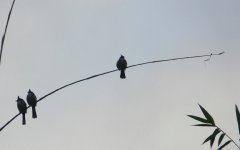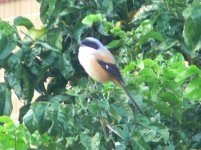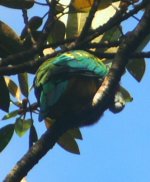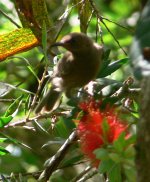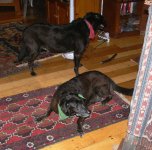John Cantelo
Well-known member
A very long, verbose trip report - please have patience!
Over the last two or three decades an old school friend has persistently invited me out to visit him in a variety of exotic locations. Unfortunately, our schedules never seemed to coincide to allow our mutual intentions, his to invite and mine to accept, to become a reality. Then I upped and retired. So it was I found myself early in December 2010 on a snowy platform in the south-east of England about to launch my nervous self on my first solo long distance flight – destination Queensland, Australia.
Although on this trip ‘lifer’ and ‘bird’ became near synonymous terms, this was primarily a long awaited social call. I had no plans for long haul drives, bug-eyed dawn to dusk birding and blindly searching every habitat with a fanatical lust for that last possible elusive lifer. Well, yes, but then again it didn’t have to be! That old friend’ just happened to be expert bird tour guide and Phil Gregory and my destination the famous Cassowary House (www.cassowary-house.com.au) which he and his wife, Sue, have been operating for the last fifteen or so years. Phil and Sue also run Sicklebill Safaris (http://sicklebillsafaris.com) so I was in very good hands! Whilst I left the question of where we might go up to my host, my preparations before the event were meticulous. I systematically read the guides, made illustrated checklists of what to expect and annotated my field lists. Naturally, hardly an iota of all this actually stuck or survived a few minutes in the field!
A lifetime of pretty much knowing what to expect and identifying birds with confidence in the UK and, to only a slightly lesser degree in Europe, didn’t prepare me at all for the perplexing diversity of Australia. It hadn't been so hard when I'd visited North America, but I didn't have this aging brain then and it was no longer so good at digesting what novel birds I might expect. Oddly, though, once I saw the birds in real life, rather than on the printed page, the difficulties quickly evaporated even if they didn’t entirely disappear. The other great advantage was birding with Phil. His experience and knowledge meant I was birding with a walking, talking, proactive, reactive and interactive bird field/site guide! This was incredibly useful since I quickly found that, particularly in the rain forest, field guides were pretty much useless. When, oh when, will someone produce a rainforest orientated field guide rather than a more conventional one? Just to make the problem clear they could call it “Looking up Birds’ Bottoms for Beginners”.
But first, the Prologue: Hong Kong …..
Saturday 4th December
Kowloon Park
I arrived in Hong Kong by mid-afternoon, tired and somewhat sleepy, and by the time I dropped my bags at the hotel I felt even worse. But there was still just time to get to Kowloon Park on HK’s excellent metro where I could sleep walk my way through some birding. Despite being very crowded the park quickly produced two bulbuls, Red-whiskered and Chinese; in part thanks to their voluble, noisy nature. Night Herons perched in the trees were more familiar even if the surroundings, groups of chattering graduating Chinese students and the backdrop of huge skyscrapers seemed both exotic and improbable. The Black Kites drifting between Mammon’s canyons were expected – I’d done my homework, remember – although a slightly odd looking Buzzard was less so. Both presumably belonging to unfamiliar eastern races, lineatus and japonicus respectively. This signalled a numerical uncertainty that dogged the trip, what forms could be classed as ‘lifers’ or merely ‘country/continent ticks’? Similarly, could the feral Alexandrine Parrots coming into roost be listed without hesitation (or guilt)? Also in the park were more ticks - Spotted Doves, Masked Laughing Thrush, Black-collared Starling and Eastern Magpie-Robins. The evening ended with the, to me at least, incongruous call of the Yellow-browed Warbler from the tree-tops – something I associate with autumn days on the Kent coast rather than the heat and urban sprawl of Hong Kong.
Over the last two or three decades an old school friend has persistently invited me out to visit him in a variety of exotic locations. Unfortunately, our schedules never seemed to coincide to allow our mutual intentions, his to invite and mine to accept, to become a reality. Then I upped and retired. So it was I found myself early in December 2010 on a snowy platform in the south-east of England about to launch my nervous self on my first solo long distance flight – destination Queensland, Australia.
Although on this trip ‘lifer’ and ‘bird’ became near synonymous terms, this was primarily a long awaited social call. I had no plans for long haul drives, bug-eyed dawn to dusk birding and blindly searching every habitat with a fanatical lust for that last possible elusive lifer. Well, yes, but then again it didn’t have to be! That old friend’ just happened to be expert bird tour guide and Phil Gregory and my destination the famous Cassowary House (www.cassowary-house.com.au) which he and his wife, Sue, have been operating for the last fifteen or so years. Phil and Sue also run Sicklebill Safaris (http://sicklebillsafaris.com) so I was in very good hands! Whilst I left the question of where we might go up to my host, my preparations before the event were meticulous. I systematically read the guides, made illustrated checklists of what to expect and annotated my field lists. Naturally, hardly an iota of all this actually stuck or survived a few minutes in the field!
A lifetime of pretty much knowing what to expect and identifying birds with confidence in the UK and, to only a slightly lesser degree in Europe, didn’t prepare me at all for the perplexing diversity of Australia. It hadn't been so hard when I'd visited North America, but I didn't have this aging brain then and it was no longer so good at digesting what novel birds I might expect. Oddly, though, once I saw the birds in real life, rather than on the printed page, the difficulties quickly evaporated even if they didn’t entirely disappear. The other great advantage was birding with Phil. His experience and knowledge meant I was birding with a walking, talking, proactive, reactive and interactive bird field/site guide! This was incredibly useful since I quickly found that, particularly in the rain forest, field guides were pretty much useless. When, oh when, will someone produce a rainforest orientated field guide rather than a more conventional one? Just to make the problem clear they could call it “Looking up Birds’ Bottoms for Beginners”.
But first, the Prologue: Hong Kong …..
Saturday 4th December
Kowloon Park
I arrived in Hong Kong by mid-afternoon, tired and somewhat sleepy, and by the time I dropped my bags at the hotel I felt even worse. But there was still just time to get to Kowloon Park on HK’s excellent metro where I could sleep walk my way through some birding. Despite being very crowded the park quickly produced two bulbuls, Red-whiskered and Chinese; in part thanks to their voluble, noisy nature. Night Herons perched in the trees were more familiar even if the surroundings, groups of chattering graduating Chinese students and the backdrop of huge skyscrapers seemed both exotic and improbable. The Black Kites drifting between Mammon’s canyons were expected – I’d done my homework, remember – although a slightly odd looking Buzzard was less so. Both presumably belonging to unfamiliar eastern races, lineatus and japonicus respectively. This signalled a numerical uncertainty that dogged the trip, what forms could be classed as ‘lifers’ or merely ‘country/continent ticks’? Similarly, could the feral Alexandrine Parrots coming into roost be listed without hesitation (or guilt)? Also in the park were more ticks - Spotted Doves, Masked Laughing Thrush, Black-collared Starling and Eastern Magpie-Robins. The evening ended with the, to me at least, incongruous call of the Yellow-browed Warbler from the tree-tops – something I associate with autumn days on the Kent coast rather than the heat and urban sprawl of Hong Kong.





